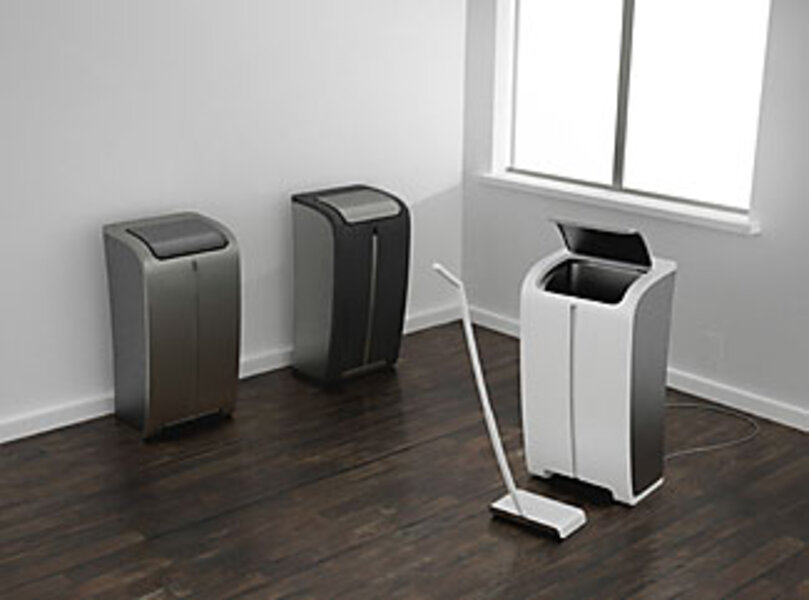What a good idea!
Loading...
A winning way to store fruit
For first-place winner Sarah O'Brien, inspiration came from spoiled peaches. She would bring them to school for a snack, but by the time she was ready to eat them, they were soft and bruised. Ethylene gas was partly to blame. That's a substance emitted by fruit when it begins to spoil. It causes other pieces of nearby fruit to ripen faster.
So Sarah came up with an idea: A fruit bowl with compartments for each piece of fruit that would minimize bruising and diminish the transfer of ethylene gas to other fruit. She named it "Elizabowl" because it resembles the ruffled collars worn during the Elizabethan era. When you take out a piece a fruit, its compartment folds up, just like the ruffles of those collars.
"I was trying to figure out a way to make something that was designed to look good full or empty," says Sarah, a graduate of the University of Louisiana. "Everything is being showcased. You don't have that surprise rotten fruit hidden at the bottom of the bowl."
Sarah spent weeks making sketches and models. A friend even helped her measure fruit at the grocery store. Her love of origami helped her think through the collapsible folds. "My dad used to work in Japan, and he would bring me back origami books," she says. "One year, we didn't have a Christmas tree at home, so I made a giant Christmas tree out of origami, with origami ornaments to put on it."
Her advice for young designers is to let their product's form follow its function. "I try to follow the problem … and I never know what it's going to look like. I know I've solved it when I like the way it looks."
Easier kitchen cleanup
Faris Elmasu says his mom's constant battle to keep the kitchen floor clean inspired his trash-can invention, which tied for third place. "She would drop something on the floor, and she would go out of her way just to get a vacuum or clean it up," he says. "And I was, like, there's an opportunity to make cleaning up more accessible in the kitchen. It's typically the dirtiest spot in the household."
So Faris, a student at San Jose State University in California, came up with BIN, a trash can that has a cordless vacuum attached to it. When the vacuum slides back into place, the plug-in trash can recharges it. Crumbs from the vacuum's storage compartment can be automatically transferred to a larger storage area at the bin's base so you don't have to empty the vacuum constantly, he says. The look of BIN was inspired by high-end furniture. "So I want it to be ... a centerpiece in your kitchen," Faris says. "It might sell for $250 to $350. It's definitely a luxury item."
Faris hopes to get a job as a product designer someday. "There are so many ways to improve products that are already out there," he says. "It's a balance between engineering and art."
Now laundry's a cinch
The next time your mom asks you to help with laundry, don't despair – it could lead to a good idea. That's what happened to Richard Hagee, a graduate of the Columbus College of Art & Design in Ohio, whose design tied for second place. He came up with his vision for a multipurpose laundry basket because he grew up washing his own clothes. "[Laundry's] long and drawn out with a lot of steps in it," he says. So he tried to make it easier.
His invention, called Opus, which means "work" in Latin, can collect laundry on the floor like a traditional basket, hang in a closet, or be thrown over your shoulder and taken to sports practice.
"You can bring your dirty clothes back with you," he says, laughing, and demonstrates how the frame collapses from a basket to a bag. Two baskets also can be linked to sort lights and darks.
As a boy, Richard was always sketching on napkins. "I would come up with little ideas that were not very usable," he jokes. "But if you keep sketching and drawing, you get better over time."
Three companies have shown an interest in his product. "I'm glad I did my own laundry," he says.
Have you ever noticed a problem around your house and tried to improve it? Well, that's what a group of industrial design students did recently. They used their creativity to come up with solutions to everyday problems at home – from cleaning the kitchen floor to preventing fruit from spoiling. Their winning ideas were featured at the International Home + Housewares Show in Chicago as part of the annual student design competition.
The contest doesn't guarantee that selected designs will make their way to store shelves, but it helps students learn about the process of inventing a product that really works (and hopefully sells) – from the first sketches to 3-D mock-ups.
"The key to being a good inventor is finding a need and creating a product that works well," says Victoria Matranga, design programs coordinator for the International Housewares Association in Rosemont, Ill. "It should be something that you'd like to have in your life. Simple solutions are the best."










